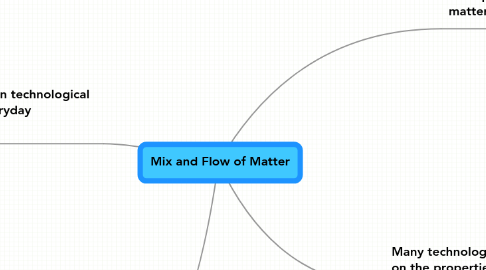
1. Fluids are used in technological devices and everyday materials.
1.1. 1.1 WHMIS Symbols and Saftey Procedures
1.1.1. Hazard Symbol: warning symbol to show that a material is hazardous.
1.1.2. WHMIS:Workplace Hazardous Materials Information System.
1.2. 1.2 The Many Uses of Fluids
1.2.1. Fluid: anything that has no fixed shape and can flow.
1.2.2. Pneumatic Systems: system that uses gas to move loads.
1.2.3. Hydraulic Systems:system that uses liquid to move loads.
2. The properties of gasses and liquids can be explained by the particle model of matter.
2.1. 3.1 Viscosity and the Effects of Temperature
2.1.1. Viscosity: liquids internal resistance or friction that keeps it from flowing.
2.2. 3.2 Density of Fluids
2.2.1. Density: mass per unit of volume.
2.3. 3.3 Density, Temperature, and Bouancy
2.3.1. Bouyant Force: upward force a fluid exerts on an object
2.3.2. Bouyancy:tendency of an object to float.
2.4. 3.4 Compression of Fluids
2.4.1. Compressibility: extent to which a substance can be compressed.
2.4.2. Incompressible: not capable of being compressed.
2.5. 3.5 Pressure in Fluids-Pascals Law
2.5.1. Pressure: measure of the amount of force applied to a given area.
2.5.2. Pascals Law: an enclosed liquid tranmits pressure equally in all directions
3. The properties of mixtures and fluids can be explained by the particle model of matter.
3.1. 2.1 Pure Substances and Mixtures
3.1.1. Pure Substance: substance made up of one type of matter
3.1.2. Mixture: combonation of two or more pure substances.
3.1.3. Mechanical Mixture: heterogeneous mixture.
3.1.4. Heterogeneous Mixture:mixture where different substances can be seen
3.1.5. Solution: homogeneous mixture.
3.1.6. Homogeneous Mixture: mixture where different substances can't be seen.
3.1.7. Suspension: cloudy ixture.
3.1.8. Colloid: cloudy mixture where particles cannot be seperated.
3.2. 2.2 Concentration and Solubility
3.2.1. Solute: substance that dissolves into a solevent.
3.2.2. Solevent: substance that dissolves a solute.
3.2.3. Concentration:amount of solute in a solevent.
3.2.4. Unsaturated Solution: solution where more solute can be dissolved into solevent.
3.2.5. Saturated Solution:solution where no more solute can be dissolved into a solevent.
3.2.6. Solubility: ability to dissolve.
3.2.7. Saturation Point: point where no more solute can be dissolved into a solevent.
3.3. 2.3 Factors Affecting Solubility
3.3.1. Aqueous Solution: solution where water is the solevent.
3.3.2. Particle Model of Matter: model that explains the behaviors of solids, liquids and gases
4. Many technologies are based on the properties of fluids
4.1. 4.1 Technologies Based on Solubility
4.2. 4.2 Technologies Based on Flow Rates and Moving Fluids
4.2.1. Pump: a device that moves fluid through or into something.
